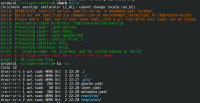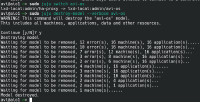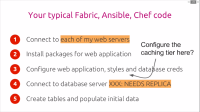Juju
Last updated: Apr 22, 2020
IMAGE GALLERY (5)
Juju is an open source application modelling tool. It allows you to deploy, configure, scale and operate your software on public and private clouds1.
- juju charms like install node, django etc and connect to mongodb
- one charm to rule them all. Devops operations
- Configuration and deployment tool
- Juju by default stores its configuration and state locally in the
~/.local/share/jujudirectory
Juju can be used locally2 using LXD.
How to connect new interfaces, services/instances when application is scaled up?
Juju excels at continue to upgrade the model once its deployed
- scaling application
- upgrading applications
- configuring applications while they are running
Things always change
Modelling software deployments?
Application is not a single server these days, its a plethora of interconnectedd services
- charm
- is a set of action and hooks
actionsare programshooksare events and signals
Developers can simulate a production like real cloud instances/interconnected environment using lightweigt LXD
Juju also has a concept of Bundles. A Bundle is a portable specification for a model with charms, configuration, and relations all specified in a declarative YAML format
Relations and applications information os provided in YAML descriptor file
sudo snap install juju --edge --classic
fish_update_completions
juju whoami
juju list-controllers
# Initializes a cloud environment.
juju bootstrap
- controller
- A Juju controller is the management node of a Juju cloud environment. It houses the database and keeps track of all the models in that environment.
juju bootstrap localhost lxd-local
juju controllers --refresh
juju whoami
juju deploy cs:bundle/mediawiki-single
juju status
juju destroy-model default
juju add-model default
juju gui --browser
juju deploy cs:bundle/openstack-base-61
- Documentation3
- Stop spending time on Configuration MAnagement - use prebuilt charms
- A software is stuff connected to other stuff
- Hosting Environment
- Machines
- Providers
- Clouds
- Juju Architecture
- Bundles
- Charmes
- Layers
- Client
- Controller
- Agents
- SOftware Medelling
- Applications
- Models
- Units
- Relations
The Juju controller will manage:
- Multiple models
- All VMs in all your running models
- Scale out, config and placement
- User accounts and identification
- Sharing and access
- Reactive Programming
- For example, in an imperative programming setting, {\displaystyle a:=b+c}a:=b+c would mean that {\displaystyle a}a is being assigned the result of {\displaystyle b+c}b+c in the instant the expression is evaluated, and later, the values of {\displaystyle b}b and {\displaystyle c}c can be changed with no effect on the value of {\displaystyle a}a. On the other hand, in reactive programming, the value of {\displaystyle a}a is automatically updated whenever the values of {\displaystyle b}b or {\displaystyle c}c change, without the program having to re-execute the statement {\displaystyle a:=b+c}a:=b+c to determine the presently assigned value of a
- deploy OS, event handling based interface management
- Bundles
- Charms
- Layers
charm layers
- built in layers, anologous to docker layers
- could be written in bash or python
charm build- reactive framework
- juju
hooks def install()relationship
- juju
- Components of a charm
- Charm store
Relationships - Provides and Requires
charm create vanilla juju add-unit -n5 ubuntu # add 5 units juju deploy ubuntu mytestmachine1 juju deploy ubuntu mytestmachine2 juju add-model --verbose mediawiki juju deploy haproxy juju deploy my-web-app juju add-relation my-web-app:website haproxy:reverseproxy juju add-unit my-web-app juju destroy-model --verbose mediawiki juju switch avi-os-
- Layer 4 or Layer 7 load balancing
- Algorithms
- Round robin
- Least connections *





